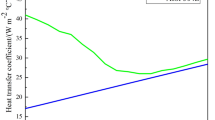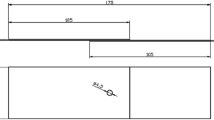Abstract
Extrusion connection is a new method of forming and manufacturing heterogeneous welded sheets. The factors that affected the bonding quality are the forming temperature, the extrusion ratio, and the guiding angle of the die, which has brought trouble to the evaluation of bonding strength and quality. A method to establish a predicted model for the bonding strength of welded sheets by integrating finite element simulations, process experiments, and artificial neural networks was developed. Finite element simulations were used to verify the process experiments and provided training data sets for the artificial neural networks. The BP neural network was used to predict the bonding strength. Due to the randomness of the weight and threshold of the BP neural network, its predicted accuracy needs to be improved, in which genetic algorithms were used to optimize consequently. The results showed that the genetic algorithm neural network model had higher reliability, and the predicted accuracy was 99.5%. Compared with the traditional BP neural network, the predicted accuracy was improved by 5.78%, and the error was reduced to 0.5%. It has good generalization ability and provides a new way for intelligent reliability evaluation of high performance heterogeneous welded sheets via extrusion.












Similar content being viewed by others
Data availability
The data obtained in the framework of this study are available to the journal upon request.
Abbreviations
- n :
-
The number of test set samples
- o i :
-
Predicted output value of the ith test set sample
- y i :
-
Expected output value of the ith test set sample
References
Zhang SJ, Wang W, Ma SB, Yan HJ, Jiao LS, Li Q (2020) A solid state bonding technology for metal plate by shear-extrusion and the analysis of microstructure and bonding strength. J Manuf Process 59:477–486
Kavan K, Shahed R, Stephan W, Stefanie R (2019) Modeling of joining by plastic deformation using a bonding interface finite element. Int J Solids Struct 160:68–79
Virendra PS, Surendra KP, Alok R, Basil K (2020) Recent research progress in solid state friction-stir welding of aluminium–magnesium alloys: a critical review. J Mater Res Technol 9(3):6217–6256
Sameer MD, Anil KB (2019) Mechanical and metallurgical properties of friction stir welded dissimilar joints of AZ91 magnesium alloy and AA6082-T6 aluminium alloy. J Magnes Alloy 7(2):264–271
Javad V, Mohammad K (2019) Diffusion bonding of aluminum-magnesium using cold rolled copper interlayer. J Alloys Compd 773:838–843
Chen X, Xia DB, Zhang JL, Huang GH, Liu K, Tang AT, Jiang B, Pan FS (2020) Ultrafine-grained AleZneMgeCu alloy processed via cross accumulative extrusion bonding and subsequent aging: Microstructure and mechanical properties. J Alloys Compd 846:156306
Walid H, Hiba A, Brahim M, Kamel T, Thierry B, Anne-Laure H, Francois B, Sébastien G, Marie-Hélène M, Djamel B (2019) Investigation of microstructure and texture evolution of a Mg/Al laminated composite elaborated by accumulative roll bonding. Mater Charact 147:242–252
Akeret R (1972) Properties of pressure welds in extruded aluminum alloy sections. J Inst Met 100:202
Plata M, Piwnik J (2000) Theoretical and experimental analysis of seam weld formation in hot extrusion of aluminum alloys. In: Proceedings of 7th International Aluminum Extrusion Technology Seminar ET 205
Donati L, Tomesani L (2004) The prediction of seam welds quality in aluminum extrusion. J Mater Process Technol 153–154:366–373
Yu JQ, Zhao GQ, Chen L (2016) Analysis of longitudinal weld seam defects and investigation of solid-state bonding criteria in porthole die extrusion process of aluminum alloy profiles. J Mater Process Technol 237:31–47
Prakash KS, Sukhomay P (2015) Multi-response optimization of process parameters in friction stir welded AM20 magnesium alloy by Taguchi grey relational analysis. J Magnes Alloy 3(1):36–46
Mohammed IU, Senthil VSK, Gopalakannan S (2016) Application of response surface methodology in optimizing the process parameters of twist extrusion process for AA6061-T6 aluminum alloy. Measurement 94:126–138
Mohammed HS, Obadah MJ, Nazzal MA, Basil MD, Hossam AK (2020) Sustainability-based evaluation of friction stir back extrusion of seamless tubular shapes. J Clean Prod 267:121972
Anand K, Birendra KB, Tamilmannan K, Sathiya P (2015) Artificial neural network modeling studies to predict the friction welding process parameters of Incoloy 800H joints. Eng Sci Technol Int J 18:394–407
Zhu YL, Cao Y, Liu CJ, Luo R, Li N, Shu G, Huang GJ, Liu Q (2020) Dynamic behavior and modified artificial neural network model for predicting flow stress during hot deformation of alloy 925. Mater Today 25:101329
Liao TW, Roberts J, Wahab MA, Okeil AM (2019) Building a multi-signal based defect prediction system for a friction stir welding process. Procedia Manuf 38:1775–1791
Chen L, Li YQ, Zhao GQ, Zhang CS, Gao FZ (2020) Multi-objective optimization and experimental investigation on hot extruded plate of high strength Al-Zn-Mg alloy. J Mater Res Technol 9(1):207–519
Hu W, Ma ZW, Ji SD, Song Q, Chen MF, Jiang WH (2020) Improving the mechanical property of dissimilar Al/Mg hybrid friction stir welding joint by PIO-ANN. J Mater Sci Technol 53:41–52
Liu G, Zhou J, Duszczyk (2008) FE analysis of metal flow and weld seam formation in aporthole die during the extrusion of a magnesium alloy into a square tube and the effect of ram speed on weld strength. J Mater Process Technol 200:185–198
Bai SW, Fang G, Zhou J (2019) Integrated physical and numerical simulations of weld seam formation during extrusion of magnesium alloy. J Mater Process Technol 266:82–95
Önder A (2019) A forming load analysis for extrusion process of AZ31 magnesium. Trans Nonferrous Metals Soc China 29:741–753
Li Y, Tae HL, Mihaela B, Jack SH (2020) An integrated process-performance model of ultrasonic composite welding based on finite element and artificial neural network. J Manuf Process 56B:1374–1380
Bai SW, Fang G, Zhou J (2020) Construction of three-dimensional extrusion limit diagram for magnesium alloy using artificial neural network and its validation. J Mater Process Technol 275:116361
Ji CM, Hu JL, Wang B, Zou YJ, Sun YG (2020) Mechanical behavior prediction of CF/PEEK-titanium hybrid laminates considering temperature effect by artificial neural network. Compos Struct 262:113367
ZhangY X, Gao XD, Katayama S (2015) Weld appearance prediction with BP neural network improved by genetic algorithm during disk laser welding. J Manuf Syst 34:53–59
Wang HY, Zhang ZX, Liu LM (2021) Prediction and fitting of weld morphology of Al alloy-CFRP welding-rivet hybrid bonding joint based on GA-BP neural network. J Manuf Process 63:109–120
Vahid YM, Mohammad RT, Ahmad R (2014) Mechanical properties and microstructure evolutions of multilayered Al–Cu composites produced by accumulative roll bonding process and subsequent annealing. Mater Sci Eng A 601:40–47
Wu K, Chang H, Maawad E, Gan WM, Brokmeier HG, Zheng MY (2010) Microstructure and mechanical properties of the Mg/Al laminated composite fabricated by accumulative roll bonding (ARB). Mater Sci Eng A 527:3073–3078
Zhao LM, Zhang ZD (2008) Effect of Zn alloy interlayer on interface microstructure and strength of diffusion-bonded Mg–Al joints. Scr Mater 58:283–286
Afghahi SSS, Jafarian M, Paidar M, Jafarian M (2016) Diffusion bonding of Al 7075 and Mg AZ31 alloys:process parameters, microstructural analysis and mechanical properties. Trans Nonferrous Metals Soc China 26:1843–1851
Liu LM, Ren DX (2011) A novel weld-bonding hybrid process for joining Mg alloy and Al alloy. Mater Des 32:3730–3735
Azizi A, Alimardan H (2016) Effect of welding temperature and duration on properties of 7075 Al to AZ31B Mg diffusion bonded joint. Trans Nonferrous Metals Soc China 26:85–92
Funding
This paper was supported by the Key Laboratory of Micro-systems and Micro-structures Manufacturing, Ministry of Education, Harbin Institute of Technology (2020KM005), and the Fundamental Research Foundation for Universities of Heilongjiang Province (LGYC2018JQ011).
Author information
Authors and Affiliations
Contributions
Lei Gao: conceptualization, methodology, writing-original draft preparation, and experimental scheme design. Li Feng: writing, reviewing, and editing. Peng Da Huo, Chao Li, and Jie Xu: algorithm help.
Corresponding authors
Ethics declarations
Ethics approval
Not applicable.
Consent to participate
Not applicable.
Consent for publication
Not applicable.
Competing interests
The authors declare no competing interests.
Additional information
Publisher’s note
Springer Nature remains neutral with regard to jurisdictional claims in published maps and institutional affiliations.
Rights and permissions
About this article
Cite this article
Gao, L., Li, F., Da Huo, P. et al. Accurate prediction of the extrusion forming bonding reliability for heterogeneous welded sheets based on GA-BP neural network. Int J Adv Manuf Technol 117, 765–774 (2021). https://doi.org/10.1007/s00170-021-07797-7
Received:
Accepted:
Published:
Issue Date:
DOI: https://doi.org/10.1007/s00170-021-07797-7




